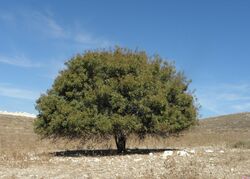Biology:Pistacia palaestina
| Pistacia palaestina | |
|---|---|

| |
| Scientific classification | |
| Kingdom: | Plantae |
| Clade: | Tracheophytes |
| Clade: | Angiosperms |
| Clade: | Eudicots |
| Clade: | Rosids |
| Order: | Sapindales |
| Family: | Anacardiaceae |
| Genus: | Pistacia |
| Species: | P. palaestina
|
| Binomial name | |
| Pistacia palaestina Boiss.
| |
Pistacia palaestina is a tree or shrub common in the Levant region (especially Israel and Syria). It is called terebinth in English, a name also used for Pistacia terebinthus, a similar tree from the western Mediterranean Basin.
Description
Pistacia palaestina is distinguished from P. terebinthus "by its egg-shaped leaflets, which are drawn into a long point, with somewhat hairy margins, and by more spreading and branching flower clusters."[1]
History
The terebinth is mentioned in the Hebrew Scriptures (or Old Testament), where the Hebrew word elah (plural elot) is used, although the word is sometimes translated as "oak". (The Hebrew word alon means "oak," and the words may be related.)
The word terebinth is found in three successive chapters of Genesis (12:6, 13:18, 14:13) in reference to the places where Abram (later Abraham) camped called "Terebinths of Mamre the Amorite".[2] Here, the traditional rendering in English is "oaks of Mamre".
It is also found in Genesis chapter 35, where Jacob commands his family to remove idols that were taken as booty from the battle in Shechem (שכם), before travelling to Bethel.
Terebinths are also found in Isaiah in possible reference to idolatry associated with the trees, although in the Septuagint and Vulgate the word is translated "idols", as the plural of "el".)
- For you will be ashamed of the terebinths that you have taken pleasure in.[3]
The best known clear reference to a terebinth (elah) in the Hebrew Scriptures is that of the Valley of Elah or "Valley of the Terebinth" (עמק האלה), where David fought Goliath (1 Samuel 17:2, 19).
At least a few references occur in Judges: Ch 4 (in reference to Heber, the Kenite, of the children of Hobab), Ch 6 (in reference to an angel of the Lord who came to visit Gideon—most versions use 'oak'), and Ch 9 (in reference to the crowning of Abimelech, by the terebinth of the pillar that was in Shechem—again most versions use 'oak'). This reference of Abimelech's crowning by an oak is actually referring to the Palestine oak, closely related to the Kermes oak. The Hebrew distinguishes the Palestine oak and the terebinth. It is also mentioned in Hosea 4:13 when Hosea is talking about Israel's spiritual adultery by sacrificing to false gods and how to repent and be forgiven in Hosea 14.
Gallery
Pistacia adds red to the landscape Mount Meron, Israel
References
Wikidata ☰ Q2916973 entry



